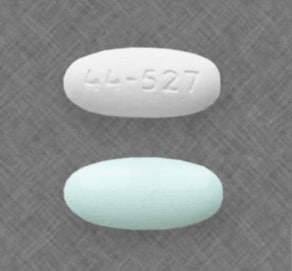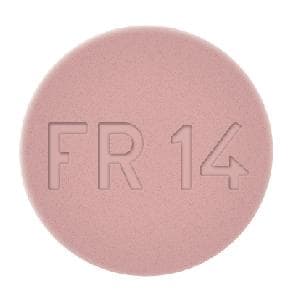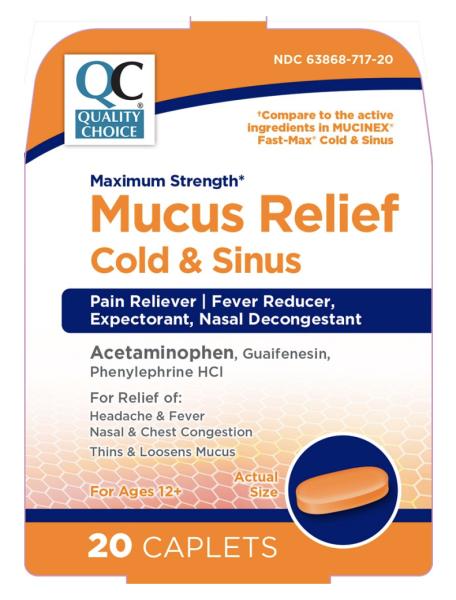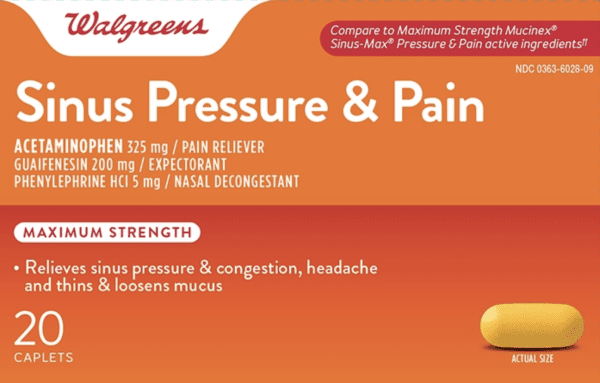Dosage Forms
Excipient information presented when available (limited, particularly for generics); consult specific product labeling. [DSC] = Discontinued product
Liquid, Oral:
Mucinex Fast-Max: Acetaminophen 650 mg, guaifenesin 400 mg, and phenylephrine hydrochloride 10 mg per 20 mL (180 mL [DSC]) [contains brilliant blue fcf (fd&c blue #1), edetate disodium, fd&c red #40, propylene glycol, sodium benzoate, sorbitol]
Mucinex Fast-Max Cold & Sinus: Acetaminophen 650 mg, guaifenesin 400 mg, and phenylephrine hydrochloride 10 mg per 20 mL (177 mL [DSC]) [contains brilliant blue fcf (fd&c blue #1), edetate disodium, fd&c red #40, propylene glycol, sodium benzoate]
Mucinex Sinus-Max: Acetaminophen 650 mg, guaifenesin 400 mg, and phenylephrine hydrochloride 10 mg per 20 mL (180 mL) [contains brilliant blue fcf (fd&c blue #1), edetate disodium, fd&c red #40, propylene glycol, sodium benzoate]
Mucinex Sinus-Max Congestion: Acetaminophen 650 mg, guaifenesin 400 mg, and phenylephrine hydrochloride 10 mg per 20 mL (180 mL) [contains brilliant blue fcf (fd&c blue #1), edetate disodium, fd&c yellow #10 (quinoline yellow), propylene glycol, sodium benzoate; menthol flavor]
Theraflu Warming Cold & Chest: Acetaminophen 325 mg, guaifenesin 200 mg, and phenylephrine hydrochloride 5 mg per 15 mL (245.5 mL [DSC]) [contains benzyl alcohol, edetate disodium, fd&c yellow #6 (sunset yellow), propylene glycol, sodium benzoate; orange flavor]
Tablet, Oral:
GoodSense Cold & Head Congest: Acetaminophen 325 mg, guaifenesin 200 mg, and phenylephrine hydrochloride 5 mg
GoodSense Pressure/Pain/Mucus: Acetaminophen 325 mg, guaifenesin 200 mg, and phenylephrine hydrochloride 5 mg
GoodSense Sinus Relief Max St: Acetaminophen 325 mg, guaifenesin 200 mg, and phenylephrine hydrochloride 5 mg [DSC] [gluten free; contains fd&c yellow #6 aluminum lake]
GoodSense Sinus Severe Daytime: Acetaminophen 325 mg, guaifenesin 200 mg, and phenylephrine hydrochloride 5 mg
Mucinex Sinus-Max Congestion: Acetaminophen 325 mg, guaifenesin 200 mg, and phenylephrine hydrochloride 5 mg [contains fd&c red #40 aluminum lake, fd&c yellow #6 aluminum lake]
Mucinex Sinus-Max Press & Pain: Acetaminophen 325 mg, guaifenesin 200 mg, and phenylephrine hydrochloride 5 mg [DSC] [contains fd&c yellow #10 aluminum lake, fd&c yellow #6 aluminum lake]
Sudafed PE Head Congestion: Acetaminophen 325 mg, guaifenesin 200 mg, and phenylephrine hydrochloride 5 mg
Tylenol Cold & Head: Acetaminophen 325 mg, guaifenesin 200 mg, and phenylephrine hydrochloride 5 mg
Tylenol Sinus Severe: Acetaminophen 325 mg, guaifenesin 200 mg, and phenylephrine hydrochloride 5 mg
Pharmacology
Mechanism of Action
Acetaminophen: Although not fully elucidated, the analgesic effects are believed to be due to activation of descending serotonergic inhibitory pathways in the CNS. Interactions with other nociceptive systems may be involved as well (Smith 2009). Antipyresis is produced from inhibition of the hypothalamic heat-regulating center.
Guaifenesin: Acts as an expectorant by increasing the effective hydration of the respiratory tract, maintains the sol layer needed for ciliary clearance and reduces the viscosity of respiratory mucus.
Phenylephrine: Causes vasoconstriction of the arterioles of the nasal mucosa.
Use: Labeled Indications
Allergies/common cold/hay fever: Temporary relief of symptoms (eg, headache, minor aches/pains, nasal congestion, sinus congestion/pressure) associated with hay fever, other respiratory allergies, or the common cold; temporarily reduces fever; helps loosen phlegm and thin bronchial secretions.
Contraindications
OTC labeling: When used for self-medication, do not use with any other drug containing acetaminophen; in combination with or within 14 days of stopping a monoamine oxidase inhibitor (MAOI); if you are hypersensitive to acetaminophen, guaifenesin, phenylephrine, or any component of the formulation.
Dosage and Administration
Dosing: Adult
Note: When calculating the maximum daily dose, consider all sources of acetaminophen (prescription and OTC) and all routes of administration. Do not exceed the maximum recommended daily dose.
Allergies/common cold/hay fever: Oral: Acetaminophen 325 mg/guaifenesin 200 mg/phenylephrine 5 mg: Two tablets every 4 hours (maximum: 10 tablets [acetaminophen 3,250 mg/guaifenesin 2,000 mg/phenylephrine 50 mg]/24 hours).
Dosing: Geriatric
Refer to adult dosing.
Dosing: Pediatric
Allergies/common cold/hay fever: Oral: Children ≥12 years and Adolescents: Refer to adult dosing
Administration
Swallow whole; do not crush, chew, or dissolve.
Storage
Store at 20°C to 25°C (68°F to 77°F).
Acetaminophen, Guaifenesin, and Phenylephrine Images
-

acetaminophen/guaifenesin/phenylephrine 325 mg / 200 mg / 5 mg -

acetaminophen/guaifenesin/phenylephrine acetaminophen 325 mg / guaifenesin 200mg / phenylephrine hydrochloride 5 mg -

acetaminophen/guaifenesin/phenylephrine acetaminophen 325 mg / guaifenesin 200 mg / phenylephrine HCl 5 mg -

acetaminophen/guaifenesin/phenylephrine 325 mg / 200 mg / 5 mg -

acetaminophen/guaifenesin/phenylephrine 325 mg / 200 mg / 5 mg -

acetaminophen/guaifenesin/phenylephrine 325 mg / 200 mg / 5 mg
Drug Interactions
Acetaminophen: May increase the serum concentration of Phenylephrine (Systemic). Monitor therapy
Alcohol (Ethyl): May enhance the hepatotoxic effect of Acetaminophen. Monitor therapy
Alpha1-Blockers: May diminish the vasoconstricting effect of Alpha1-Agonists. Similarly, Alpha1-Agonists may antagonize Alpha1-Blocker vasodilation. Monitor therapy
AtoMOXetine: May enhance the hypertensive effect of Sympathomimetics. AtoMOXetine may enhance the tachycardic effect of Sympathomimetics. Monitor therapy
Barbiturates: May increase the metabolism of Acetaminophen. This may 1) diminish the effect of acetaminophen; and 2) increase the risk of liver damage. Exceptions: Amobarbital; Butabarbital; Butalbital; Methohexital; PENTobarbital; Secobarbital; Thiopental. Monitor therapy
Benzylpenicilloyl Polylysine: Alpha1-Agonists may diminish the diagnostic effect of Benzylpenicilloyl Polylysine. Management: Consider use of a histamine skin test as a positive control to assess a patient's ability to mount a wheal and flare response. Consider therapy modification
Busulfan: Acetaminophen may increase the serum concentration of Busulfan. Monitor therapy
Cannabinoid-Containing Products: May enhance the tachycardic effect of Sympathomimetics. Exceptions: Cannabidiol. Monitor therapy
CarBAMazepine: May increase the metabolism of Acetaminophen. This may 1) diminish the effect of acetaminophen; and 2) increase the risk of liver damage. Monitor therapy
Chloroprocaine: May enhance the hypertensive effect of Phenylephrine (Systemic). Monitor therapy
CloZAPine: May diminish the therapeutic effect of Phenylephrine (Systemic). Monitor therapy
Cocaine (Topical): May enhance the hypertensive effect of Sympathomimetics. Management: Consider alternatives to use of this combination when possible. Monitor closely for substantially increased blood pressure or heart rate and for any evidence of myocardial ischemia with concurrent use. Consider therapy modification
Dapsone (Topical): May enhance the adverse/toxic effect of Methemoglobinemia Associated Agents. Monitor therapy
Dasatinib: Acetaminophen may enhance the hepatotoxic effect of Dasatinib. Dasatinib may increase the serum concentration of Acetaminophen. Consider therapy modification
Doxofylline: Sympathomimetics may enhance the adverse/toxic effect of Doxofylline. Monitor therapy
Ergot Derivatives: May enhance the hypertensive effect of Alpha1-Agonists. Ergot Derivatives may enhance the vasoconstricting effect of Alpha1-Agonists. Exceptions: Ergoloid Mesylates; Nicergoline. Avoid combination
FentaNYL: Alpha1-Agonists may decrease the serum concentration of FentaNYL. Specifically, fentanyl nasal spray serum concentrations may decrease and onset of effect may be delayed. Monitor therapy
Flucloxacillin: May enhance the adverse/toxic effect of Acetaminophen. Specifically, the risk for high anion gap metabolic acidosis may be increased. Monitor therapy
Fosphenytoin-Phenytoin: May decrease the serum concentration of Acetaminophen. Specifically, serum concentrations of acetaminophen may be decreased (leading to decreased efficacy), but the formation of the toxic N-acetyl-p-benzoquinone imine (NAPQI) metabolite may be increased (leading to increased hepatotoxicity). Monitor therapy
Guanethidine: May enhance the arrhythmogenic effect of Sympathomimetics. Guanethidine may enhance the hypertensive effect of Sympathomimetics. Monitor therapy
Hyaluronidase: May enhance the vasoconstricting effect of Phenylephrine (Systemic). Management: Avoid the use of hyaluronidase to enhance dispersion or absorption of phenylephrine. Use of hyaluronidase for other purposes in patients receiving phenylephrine may be considered as clinically indicated. Avoid combination
Imatinib: Acetaminophen may enhance the hepatotoxic effect of Imatinib. Monitor therapy
Iobenguane Radiopharmaceutical Products: Alpha1-Agonists may diminish the therapeutic effect of Iobenguane Radiopharmaceutical Products. Management: Discontinue all drugs that may inhibit or interfere with catecholamine transport or uptake for at least 5 biological half-lives before iobenguane administration. Do not administer these drugs until at least 7 days after each iobenguane dose. Avoid combination
Ioflupane I 123: Phenylephrine (Systemic) may diminish the diagnostic effect of Ioflupane I 123. Monitor therapy
Isoniazid: May enhance the adverse/toxic effect of Acetaminophen. Monitor therapy
LamoTRIgine: Acetaminophen may decrease the serum concentration of LamoTRIgine. Monitor therapy
Linezolid: May enhance the hypertensive effect of Sympathomimetics. Management: Reduce initial doses of sympathomimetic agents, and closely monitor for enhanced pressor response, in patients receiving linezolid. Specific dose adjustment recommendations are not presently available. Consider therapy modification
Local Anesthetics: Methemoglobinemia Associated Agents may enhance the adverse/toxic effect of Local Anesthetics. Specifically, the risk for methemoglobinemia may be increased. Monitor therapy
MetyraPONE: May increase the serum concentration of Acetaminophen. More importantly, by inhibiting the conjugative metabolism of acetaminophen, metyrapone may shift the metabolism towards the oxidative route that produces a hepatotoxic metabolite. Monitor therapy
Mipomersen: Acetaminophen may enhance the hepatotoxic effect of Mipomersen. Monitor therapy
Monoamine Oxidase Inhibitors: May enhance the hypertensive effect of Alpha1-Agonists. While linezolid is expected to interact via this mechanism, management recommendations differ from other monoamine oxidase inhibitors. Refer to linezolid specific monographs for details. Exceptions: Linezolid. Avoid combination
Nitric Oxide: May enhance the adverse/toxic effect of Methemoglobinemia Associated Agents. Combinations of these agents may increase the likelihood of significant methemoglobinemia. Monitor therapy
Phenylephrine (Systemic): Acetaminophen may increase the serum concentration of Phenylephrine (Systemic). Monitor therapy
Prilocaine: Methemoglobinemia Associated Agents may enhance the adverse/toxic effect of Prilocaine. Combinations of these agents may increase the likelihood of significant methemoglobinemia. Management: Monitor patients for signs of methemoglobinemia (e.g., hypoxia, cyanosis) when prilocaine is used in combination with other agents associated with development of methemoglobinemia. Avoid lidocaine/prilocaine in infants receiving such agents. Monitor therapy
Probenecid: May increase the serum concentration of Acetaminophen. Probenecid may also limit the formation of at least one major non-toxic metabolite, possibly increasing the potential for formation of the toxic NAPQI metabolite. Consider therapy modification
Propacetamol: May increase the serum concentration of Phenylephrine (Systemic). Management: Monitor patients closely for increased side effects of phenylephrine if propacetamol is used concomitantly. Patients with underlying blood pressure issues or arrhythmias may need closer monitoring and may warrant consideration of alternative therapies. Monitor therapy
Sodium Nitrite: Methemoglobinemia Associated Agents may enhance the adverse/toxic effect of Sodium Nitrite. Combinations of these agents may increase the likelihood of significant methemoglobinemia. Monitor therapy
Solriamfetol: Sympathomimetics may enhance the hypertensive effect of Solriamfetol. Monitor therapy
SORAfenib: Acetaminophen may enhance the hepatotoxic effect of SORAfenib. SORAfenib may increase the serum concentration of Acetaminophen. Consider therapy modification
Sympathomimetics: May enhance the adverse/toxic effect of other Sympathomimetics. Monitor therapy
Tedizolid: May enhance the hypertensive effect of Sympathomimetics. Tedizolid may enhance the tachycardic effect of Sympathomimetics. Monitor therapy
Tricyclic Antidepressants: May enhance the therapeutic effect of Alpha1-Agonists. Tricyclic Antidepressants may diminish the therapeutic effect of Alpha1-Agonists. Monitor therapy
Vitamin K Antagonists (eg, warfarin): Acetaminophen may enhance the anticoagulant effect of Vitamin K Antagonists. This appears most likely with daily acetaminophen doses exceeding 1.3 or 2 g/day for multiple consecutive days. Monitor therapy
Adverse Reactions
See individual agents.
Warnings/Precautions
Concerns related to adverse effects:
- Hepatotoxicity: Acetaminophen has been associated with acute liver failure, at times resulting in liver transplant and death. Hepatotoxicity is usually associated with excessive acetaminophen intake and often involves more than one product that contains acetaminophen. Do not exceed the maximum recommended daily dose (>4 g daily). In addition, chronic daily dosing may also result in liver damage in some patients.
- Hypersensitivity/anaphylactic reactions: Hypersensitivity and anaphylactic reactions have been reported; discontinue immediately if symptoms of allergic or hypersensitivity reactions occur.
- Skin reactions: Serious and potentially fatal skin reactions, including acute generalized exanthematous pustulosis (AGEP), Stevens-Johnson syndrome (SJS), and toxic epidermal necrolysis (TEN) have occurred rarely with acetaminophen use. Discontinue therapy at the first appearance of skin rash, skin reddening, or blisters.
Disease-related concerns:
- Cardiovascular disease: Use with caution in patients with cardiovascular disease (including hypertension and ischemic heart disease).
- Diabetes: Use with caution in patients with diabetes mellitus.
- Ethanol use: Use with caution in patients with alcoholic liver disease; consuming ≥3 alcoholic drinks/day may increase the risk of liver damage. Avoid ethanol or limit to <3 alcoholic drinks/day.
- Hepatic impairment: Use with caution in patients with hepatic impairment or active liver disease.
- Increased intraocular pressure/glaucoma: Use with caution in patients with increased intraocular pressure or glaucoma.
- Prostatic hyperplasia/urinary obstruction: Use with caution in patients with prostatic hyperplasia and/or GU obstruction.
- Thyroid dysfunction: Use with caution in patients with thyroid dysfunction.
Concurrent drug therapy issues:
- Drug-drug interactions: Potentially significant interactions may exist, requiring dose or frequency adjustment, additional monitoring, and/or selection of alternative therapy. Consult drug interactions database for more detailed information.
Special populations:
- Elderly: Use with caution in the elderly; more likely to experience adverse reactions to sympathomimetics.
Dosage form specific issues:
- Benzyl alcohol and derivatives: Some dosage forms may contain sodium benzoate/benzoic acid; benzoic acid (benzoate) is a metabolite of benzyl alcohol; large amounts of benzyl alcohol (≥99 mg/kg/day) have been associated with a potentially fatal toxicity ("gasping syndrome") in neonates; the "gasping syndrome" consists of metabolic acidosis, respiratory distress, gasping respirations, CNS dysfunction (including convulsions, intracranial hemorrhage), hypotension, and cardiovascular collapse (AAP ["Inactive" 1997]; CDC 1982); some data suggests that benzoate displaces bilirubin from protein binding sites (Ahlfors 2001); avoid or use dosage forms containing benzyl alcohol derivative with caution in neonates. See manufacturer’s labeling.
- Propylene glycol: Some dosage forms may contain propylene glycol; large amounts are potentially toxic and have been associated hyperosmolality, lactic acidosis, seizures, and respiratory depression; use caution (AAP 1997; Zar 2007).
Other warnings/precautions:
- Dosage limit: Limit acetaminophen dose to <4 g/day.
- Self-medication (OTC use): When used for self-medication (OTC), patients with persistent or chronic cough (associated with COPD, asthma or smoking) and/or productive cough (eg, copious amounts of phlegm) should be evaluated by a healthcare provider prior to use. Discontinue use and notify healthcare provider if pain, cough, or nasal congestion gets worse or lasts >7 days; fever gets worse or lasts >3 days; cough comes back or occurs with rash or headache that lasts; if any new symptoms or nervousness, dizziness, or sleeplessness occur; or if redness or swelling is present.
Pregnancy
Pregnancy Considerations
Refer to individual agents
Patient Education
- Discuss specific use of drug and side effects with patient as it relates to treatment. (HCAHPS: During this hospital stay, were you given any medicine that you had not taken before? Before giving you any new medicine, how often did hospital staff tell you what the medicine was for? How often did hospital staff describe possible side effects in a way you could understand?)
- Patient may experience dizziness, anxiety, or trouble sleeping. Have patient report immediately to prescriber signs of liver problems (dark urine, fatigue, lack of appetite, nausea, abdominal pain, light-colored stools, vomiting, or yellow skin), unable to pass urine, change in amount of urine passed, or signs of Stevens-Johnson syndrome/toxic epidermal necrolysis (red, swollen, blistered, or peeling skin [with or without fever]; red or irritated eyes; or sores in mouth, throat, nose, or eyes) (HCAHPS).
- Educate patient about signs of a significant reaction (eg, wheezing; chest tightness; fever; itching; bad cough; blue skin color; seizures; or swelling of face, lips, tongue, or throat). Note: This is not a comprehensive list of all side effects. Patient should consult prescriber for additional questions.
Intended Use and Disclaimer: Should not be printed and given to patients. This information is intended to serve as a concise initial reference for health care professionals to use when discussing medications with a patient. You must ultimately rely on your own discretion, experience, and judgment in diagnosing, treating, and advising patients.



